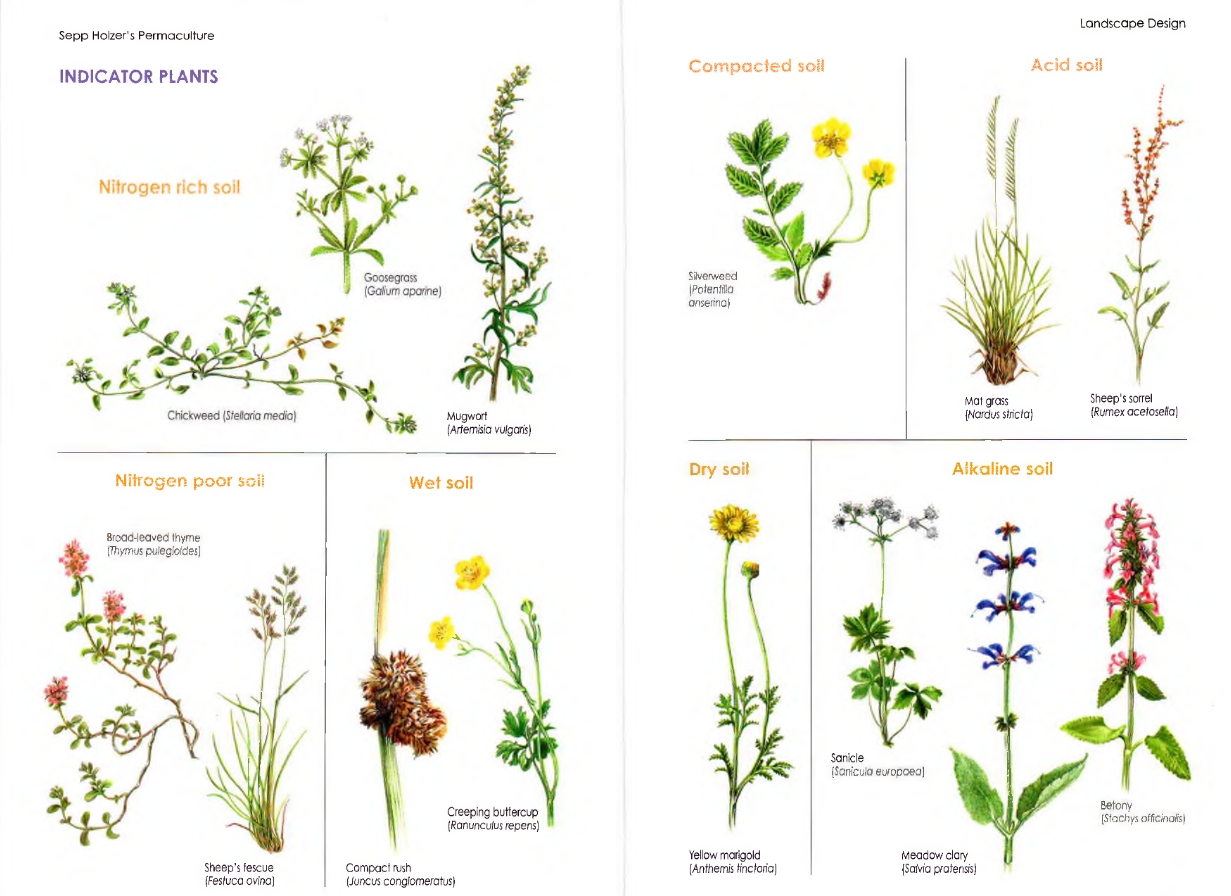When paying attention to the kind of plants that are naturally growing in a place, a lot can be said about the soil conditions without having to take the shovel out. This can help a lot in determining what cultivated plants can be grown well without amending the soil. Often times conditions may vary considerably in a garden or on a site. These varying micro climates can be used to your advantage to grow a wider range of trees, shrubs and herbaceous plants.
Here is an excerpt from Sepp Holzer’s book – Permaculture:
The plants growing in an area tell us a great deal about the nutrient ratio, pH value and the general condition of the soil. With a little practice, it is possible to assess the soil conditions based on the vegetation growing in the area. If there are nettles, hogweed or orache then the soil is rich in nitrogen. In this soil I can grow plants that need a great deal of nutrients like root vegetables and tubers. If there is a large quantity of sorrel, the land will be suitable for growing Jerusalem artichokes (Helianthus tuberosus) and sunflowers (Helianthus annuus), because they take up the excess nitrogen and provide valuable green material, tubers and seeds. In this way I deprive the orache and nettles of nutrients. They are quickly overshadowed by the other plants, which have grown tall, and begin to die.
It is important not to exclude any plants when assessing the soil conditions. You will need as many indicator plants as possible to make an accurate analysis. Certain combinations of plants or an above average number or certain varieties can help you to determine the soil conditions immediately. To give you an idea of this I have made a short list of indicator plants:
Nitrogen rich soil:
Chickweed (Stellaria media)
Stinging nettle (Urtica dioica)
Annual nettle (Urtica urens)
Cow parsley (Anthriscus sylvestris)
Hogweed (Heracleum sphondylium)
Elderberry (Sambucus nigra)
Common orache (Atriplex patula)
Goosegrass (Galium aparine)
Shepherd’s purse (Capsella bursa-pastoris)
Fathen (Chenopodium album)
Mugwort (Artemisia vulgaris)
Nitrogen poor soil:
Sweet vernal grass (Anthoxanthum odoratum)
Sheep’s fescue (Festuca ovina)
Mouse-ear hawkweed (Hieracium pilosella)
Corn chamomile (Anthem is arvensis)
Broad-leaved thyme (Thymus pulegioides)
Alkaline soil:
Meadow clary (Salvia pratensis)
Pheasant’s eye (Adonis aestivalis)
Forking larkspur (Consolida regalis)
Salad burnet (Sanguisorba minor)
Betony (Stachys officinalis)
Sanicle (Sanicula europaea)
Blue moor grass (Sesleria varia)
Acid soil:
Sheep’s sorrel (Rumex acetosella)
Bracken (Pteridium aquilinum)
Heather (Calluna vulgaris)
Bilberry (Vaccinium myrtillus)
Corn chamomile (Anthem is arvensis)
Creeping soft grass (Holcus mollis)
Wavy hair grass (Avenella flexuosa)
Mat grass (Nardus stricta)
Dry soil:
Bugloss (Lycopsis arvensis)
Whitlow grass (Erophila verna)
Broad-leaved thyme (Thymus pulegioides)
Golden marguerite (Anthemis tinctoria)
Wet soil:
Wood club rush (Scirpus sylvaticus)
Purple moor grass (Molinia caerulea)
Corn mint (Mentha arvensis)
Creeping buttercup (Ranunculus repens)
Coltsfoot (Tussilago farfara)
Soft rush (Juncus effusus)
Com pact rush (Juncus conglomeratus)
Compacted soil:
Field horsetail (Equisetum arvense)
Dandelion (Taraxacum officinale)
Greater plantain (Plantago major)
Silverweed (Potentilla anserina)
For more info please check out Sepp Holzer’s book, we can only highly recommend it for anyone into gardening, homesteading or even farming.


